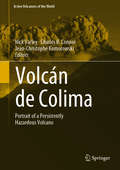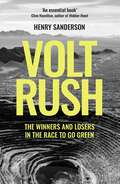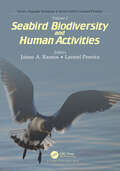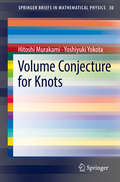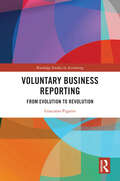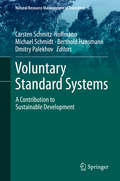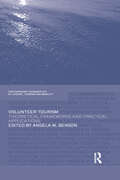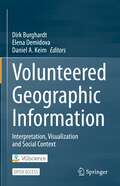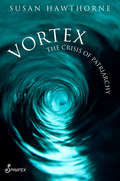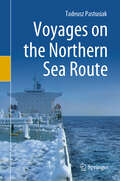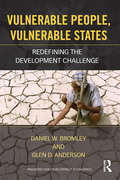- Table View
- List View
Volcanology: Processes, Deposits, Geology and Resources (Springer Textbooks in Earth Sciences, Geography and Environment)
by Ray Cas Guido Giordano John V. WrightThis book is a substantially updated, revised and extended version of the book Volcanic Successions, published by Cas and Wright back in 1987. Divided into six major parts, it offers comprehensive information on magma properties; fragmentation processes; subaerial and subaqueous lava types and field textures; sub-volcanic intrusions; explosive or pyroclastic eruptions and deposits; surface sedimentary processes; hydrothermal alteration and lithification, and effects on volcanic rock textures; terminology and approaches to describing and mapping volcanic rocks and terrains; geology of volcanoes and facies models; volcanism and tectonic setting; and to conclude, volcanic-hosted resources. It is a highly up-to-date text, presenting a coherent flow of topics, together with excellent visual material to illustrate key points and deposit features. The new authorship team consists of Ray Cas, Guido Giordano and John Wright, all of whom have extensive experience across the complete spectrum of volcanological processes and deposit types discussed in this exciting new book. The authors approach the diversity of products in volcanic terrains as facies, and use facies analysis and interpretation as a means of constructing facies models for different volcanic settings and their resources. The book is intended as a textbook and research reference book for senior undergraduate and graduate students, researchers and professionals alike.
Volcán de Colima: Portrait of a Persistently Hazardous Volcano (Active Volcanoes of the World)
by Nick Varley Charles B. Connor Jean-Christophe KomorowskiThis book represents a comprehensive coverage of the current state of knowledge of Volcán de Colima: its history, its eruptive mechanism, the generation and interpretation of monitoring data, and the risk presented to the local population. The volume pulls together the results of the most important studies of recent years from many areas of volcanology: the geology of its eruptive products; geophysical and geochemical studies of the signals measured that relate to the generation and movement of magma; experimental analysis of its internal processes and the social complexities relating to the risk imposed by future eruptions. Volcán de Colima is an important volcano: it has frequent large Plinian or sub-Plinian eruptions; its activity frequently switches between various regimes, which provides the opportunity to study these transitions from their cause to their impact; and it is a volcano which poses a significant threat to a large population.
Volt Rush: The Winners and Losers in the Race to Go Green
by Henry Sanderson'A remarkably hopeful and useful book...The climate crisis leaves us no choice but to build a new world and as Sanderson makes clear, we are capable of making it a better one than the dirty and dangerous planet we&’ve come to take for granted.' Bill McKibben, Observer book of the week We depend on a handful of metals and rare earths to power our phones and computers. Increasingly, we rely on them to power our cars and our homes. Whoever controls these finite commodities will become rich beyond imagining. Sanderson journeys to meet the characters, companies, and nations scrambling for the new resources, linking remote mines in the Congo and Chile&’s Atacama Desert to giant Chinese battery factories, shadowy commodity traders, secretive billionaires, a new generation of scientists attempting to solve the dilemma of a &‘greener&’ world.
Volume 1: Seabird Biodiversity and Human Activities (Aquatic Sciences)
by Jaime A. RamosSeabirds are global travellers connecting oceans and seas all over the world, and facing multiple threats at local and global scales. Seabirds are long-lived top predators, reflecting changes at lower trophic levels, and are good models to assess ecological changes produced by human societies. Thus, world-wide collaborations are needed to understand seabird ecology and to develop effective conservation measures benefitting both humans and seabird populations.This book provides a modern overview on seabird biodiversity studies: it begins by covering the most up-to-date techniques to study seabirds, and then focus on pragmatic issues related with interactions between seabirds and humans, the use of seabirds as ecological indicators and conservation of seabirds. It gives an updated insight on all these topics and highlights gaps that need further development for a comprehensive understanding of the relationships between seabirds and human actions.This book covers the response of the seabird research community to a biodiversity crisis aiming to contribute towards environmental sustainability. It should provide inspiration to a wide range of professionals and students, including the much needed world-wide collaboration between research groups and practitioners. In this way seabird research and conservation provide an inspiration for the solution of global issues such as climate change.
Volume 2: An Ecosystemic View of Anthropogenic Impacts (Marine Science Series)
by Juan M. Molina Gabriela E. BlasinaMarine systems face a multitude of anthropogenic stressors such as climate change, recreational and commercial fishing, aquaculture practices, pollution, and coastal urbanization. These stressors exert escalating pressure on marine ecosystems, leading to noticeable changes in habitat conditions as well as alterations in the abundance and diversity of their communities. Understanding the impacts of these stressors proves challenging due to their interactions with various factors, such as species richness, environmental fluctuations, system openness, stressor tolerance, and the occurrence rate and intensity of each stressor. Therefore, a comprehensive analysis of the entire ecosystem is crucial. It is essential to consider the unique characteristics of each marine environment when assessing the cumulative stress that affects them. This book provides insights into the functioning of marine ecosystems and their responses to both natural and human-induced drivers within the framework of sustainable marine resource utilization. This book will make a valuable contribution to the scientific community, serving as a resource to inform decision-makers and the general public about the current state of knowledge regarding the marine environment and the human footprints on our seas.
Volume 5: Maritime Communities and Vegetation of Open Habitats
by J. S. RodwellBritish Plant Communities is the first systematic and comprehensive account of the vegetation types of this country. It covers all natural, semi-natural and major artificial habitats in Great Britain (but not Northern Ireland), representing the fruits of fifteen years of research by leading plant ecologists. The book breaks new ground in wedding the rigorous interest in the classification of plant communities that has characterized Continental phytosociology with the deep concern traditional in Great Britain to understand how vegetation works. The published volumes have been greeted with universal acclaim, and the series has become firmly established as a framework for a wide variety of teaching, research and management activities in ecology, conservation and land-use planning.
Volume Conjecture for Knots (SpringerBriefs in Mathematical Physics #30)
by Hitoshi Murakami Yoshiyuki YokotaThe volume conjecture states that a certain limit of the colored Jones polynomial of a knot in the three-dimensional sphere would give the volume of the knot complement. Here the colored Jones polynomial is a generalization of the celebrated Jones polynomial and is defined by using a so-called R-matrix that is associated with the N-dimensional representation of the Lie algebra sl(2;C). The volume conjecture was first stated by R. Kashaev in terms of his own invariant defined by using the quantum dilogarithm. Later H. Murakami and J. Murakami proved that Kashaev’s invariant is nothing but the N-dimensional colored Jones polynomial evaluated at the Nth root of unity. Then the volume conjecture turns out to be a conjecture that relates an algebraic object, the colored Jones polynomial, with a geometric object, the volume.In this book we start with the definition of the colored Jones polynomial by using braid presentations of knots. Then we state the volume conjecture and give a very elementary proof of the conjecture for the figure-eight knot following T. Ekholm. We then give a rough idea of the “proof”, that is, we show why we think the conjecture is true at least in the case of hyperbolic knots by showing how the summation formula for the colored Jones polynomial “looks like” the hyperbolicity equations of the knot complement.We also describe a generalization of the volume conjecture that corresponds to a deformation of the complete hyperbolic structure of a knot complement. This generalization would relate the colored Jones polynomial of a knot to the volume and the Chern–Simons invariant of a certain representation of the fundamental group of the knot complement to the Lie group SL(2;C).We finish by mentioning further generalizations of the volume conjecture.
Voluntary Business Reporting: From Evolution to Revolution (Routledge Studies in Accounting)
by Giacomo PigattoUnderstanding the dynamic landscape of voluntary business reporting is crucial for navigating the evolving complexities of accounting practices, towards achieving a more sustainable and equitable world. This book provides a comprehensive exploration of the evolution and revolutions happening within the field of voluntary business reporting.The book begins by tracing the development of voluntary business reporting to the present day, examining the motivations behind voluntary reporting practices, including agency theory, stakeholder theory, and institutional perspectives. It offers a thorough overview of voluntary business reporting, its evolution in the business world, and its increasing relevance for disclosing nonfinancial information alongside – and often integrated with – financial information. Through empirical insights and case studies, the book uncovers instances where voluntary reporting diverges from traditional theories, highlighting factors such as chance discoveries and power struggles. Furthermore, it analyzes three revolutions characterizing voluntary reporting: (1) the mandatorization (i.e., the slow yet steady process of codification and regulation), (2) the broadening scope towards a multi-stakeholder perspective, and (3) the harmonization and integration of voluntary reporting standards and frameworks. It concludes by reflecting on the unresolved issues and challenges facing the field, emphasizing the need for ongoing research and critical reflection to advance the practice of voluntary reporting in alignment with broader societal goals.With a focus on the implications of voluntary reporting for stakeholders, businesses, and regulatory bodies, the book equips readers with actionable insights. It caters primarily to accounting and business reporting scholars. Additionally, it serves as a valuable resource for students in related disciplines and business reporting practitioners seeking insights into evolving trends and future developments in voluntary reporting practices.
Voluntary Environmental Agreements: Process, Practice and Future Use
by Patrick Ten BrinkVoluntary environmental agreements (VEAs) – generally agreements between government and business – have been regarded by many as a key new instrument for meeting environmental objectives in a flexible manner. Their performance to date has, however, also led to considerable criticism, with several parties arguing that they are methods for avoiding real action that goes beyond "business-as-usual". Is either of these positions justified?The aim of this book is to highlight and learn the lessons from existing experience, looking not just at results but also at specific elements of agreements and also at the process of the agreement itself. Lessons are drawn from experience from across the world, covering the full range of environmental challenges, and from the perspective of key stakeholder groups. Importantly, the book also presents tools for assessing and improving existing agreements and includes recommendations and guidelines for future agreements in key areas such as climate change. It also deals at length with the problem of how such agreements might be used in developing and transitional economies.The overall view of the book is that there is a real potential for the future use of VEAs as part of the policy mix and as a tool for sharing the responsibility for meeting environmental objectives. For the agreements to play this role, however, significant steps are needed to ensure that they are effective, efficient, equitable and appropriately linked to a portfolio of other instruments.The book is divided into four sections. First, existing agreements, their development and efficacy are considered; second, the prospects for voluntary agreements in developing and transitional economies are discussed; third, a range of authors examine the role of VEAs as part of the policy mix to combat climate change; and, finally, the book concludes with an examination of how new tools for evaluating and improving VEAs could be utilized in the future.Voluntary Environmental Agreements will be of interest not only to academics, governments and businesses wishing to understand this specific instrument, but also to those already implementing or considering applying VEAs to meet their environmental objectives.
Voluntary Standard Systems
by Michael Schmidt Carsten Schmitz-Hoffmann Berthold Hansmann Dmitry PalekhovEmerging to the forefront of sustainable production and consumption are a promising and rapidly evolving concept known as Voluntary Standard Systems (VSS). They encompass the three pillars of sustainability - social, environmental and economic aspects and consequently they can be considered as a tool, which makes sustainable development visible. Currently, they are becoming a significant element in international trade and in the promotion of sustainable development strategies, especially in the context of globalised markets and supply chains. This volume provides a comprehensive overview of the current VSS concepts: from their nature and functioning, to the future outlook for their development. It places VSS in the broader context of global development issues and challenges, including development policy and international sustainability commitments, progress towards achieving 'green economy' and meeting climate protection targets. The volume contains also a representative selection of case studies which demonstrate their wide range of application in different sectors of the economy.
Volunteer Tourism: Theoretical Frameworks and Practical Applications (Contemporary Geographies of Leisure, Tourism and Mobility)
by Angela M. BensonVolunteer Tourism is one of the major growth areas in contemporary tourism, where tourists for various reasons seek alternative goodwill experiences and activities. To meet this demand there has been a surge in volunteer programmes offered in range of destinations organized by a variety of charities and tour operators which is predicted to continue to grow in the future. Volunteer Tourism provides an in-depth analysis of the complex issues associated with traditional and contemporary volunteer tourism. Reflecting the growth in this phenomenon, this book provides a cohesive collection of chapters written from a range of international expert scholars and researchers. The theoretically rich, practically applied and empirically grounded contributions are based on current and diverse research in the area. This groundbreaking volume explores topics which have not been addressed in the literature before, such as the impact on host communities, introducing new areas and ideas to the field. The diverse range of themes are identified and addressed, including volunteer tourism and sustainability to, uniquely, the examination of volunteer tourism stakeholders – volunteers themselves, the host-to-guest exchange, and the organizations – and management of volunteers. These themes are examined in a range of international case studies, demonstrating the wide range of issues associated with volunteer tourism. This volume is a timely addition offering an innovative approach to the area. Volunteer Tourism will be of interest to both students and researchers interested in tourism, leisure and development, as well as non-academics, practitioners, NGOs government officials at all levels.
Volunteered Geographic Information: Interpretation, Visualization and Social Context
by Dirk Burghardt Elena Demidova Daniel A. KeimThis open access book includes methods for retrieval, semantic representation, and analysis of Volunteered Geographic Information (VGI), geovisualization and user interactions related to VGI, and discusses selected topics in active participation, social context, and privacy awareness. It presents the results of the DFG-funded priority program "VGI: Interpretation, Visualization, and Social Computing" (2016-2023).The book includes three parts representing the principal research pillars within the program. Part I "Representation and Analysis of VGI" discusses recent approaches to enhance the representation and analysis of VGI. It includes semantic representation of VGI data in knowledge graphs; machine-learning approaches to VGI mining, completion, and enrichment as well as to the improvement of data quality and fitness for purpose. Part II "Geovisualization and User Interactions related to VGI" book explores geovisualizations and user interactions supporting the analysis and presentation of VGI data. When designing these visualizations and user interactions, the specific properties of VGI data, the knowledge and abilities of different target users, and technical viability of solutions need to be considered. Part III "Active Participation, Social Context and Privacy Awareness" of the book addresses the human impact associated with VGI. It includes chapters on the use of wearable sensors worn by volunteers to record their exposure to environmental stressors on their daily journeys, on the collective behavior of people using location-based social media and movement data from football matches, and on the motivation of volunteers who provide important support in information gathering, filtering and analysis of social media in disaster situations.The book is of interest to researchers and advanced professionals in geoinformation, cartography, visual analytics, data science and machine learning.
Vom GREEN Campus zur ORANGE Alma Mater: Nachhaltig leben, lehren und forschen
by Julia KrauseNachhaltigkeit an Hochschulen braucht einen neuen Ansatz – umfassend, vernetzt und strategisch. Hochschulen tragen die Verantwortung, Nachhaltigkeit in Lehre, Forschung und Campusleben ganzheitlich zu verankern und als Vorbild für Gesellschaft und Zukunft zu wirken. Dieses Buch zeigt, wie Hochschulen Nachhaltigkeit als festen Bestandteil ihrer Identität etablieren und alle relevanten Bereiche sowie interne und externe Akteure einbeziehen können. Mit dem ORANGE-Konzept (Orientation, Research, Alliance, Networks, Governance, Education) präsentiert die Autorin eine praxisnahe Roadmap, um Nachhaltigkeit systematisch und Inspirierend umzusetzen. Das Modell macht die wichtigsten Handlungsfelder sichtbar, fördert den Austausch und motiviert dazu, innovative Wege zu gehen – einfach, verständlich und für alle Stakeholder zugänglich. Das Buch richtet sich an Hochschulleitungen, Nachhaltigkeitsbeauftragte, Forschende und alle, die Hochschulen als Motor nachhaltiger Transformation begreifen. Es lädt dazu ein, Nachhaltigkeit kreativ und intuitiv zu gestalten und die Zukunft der Hochschullandschaft aktiv mitzuprägen. Der Inhalt Grundlagen der Nachhaltigkeit und Status Quo der Bewegung an Hochschulen Das ORANGE-Konzept Die ORANGE Alma Mater – ein Ort des Wandels Die Hochschule von morgen – Vision einer nachhaltigen Zukunftshochschule
Vom Strandkorb aus betrachtet: Faszinierendes, Überraschendes und Unvermutetes von der Meeresküste
by Bruno P. KremerDieses Buch sensibilisiert Strandurlauber und am Lebensraum Meer interessierte Menschen für die zahlreichen Naturphänomene, denen sie dort begegnen können. Schon nach wenigen Leseproben sind Sie über Fakten und Phänomene aus der belebten und unbelebten maritimen Umwelt bestens orientiert und können im Kreise anderer See- und Sehleute absolut kompetent mitreden und sogar Wetten gewinnen – versprochen! Unsere Küstensäume sind unglaublich interessante und ungewöhnliche Erfahrungsräume, die zu vielerlei Fragen anregen: Was ist mit den Schaumflocken am Spülsaum? Wie erklären sich die Löcher in den hier versammelten Muschelschalen? Wie hängen Wasser, Wind und Wellen zusammen? Und warum ist Meerwasser überhaupt salzig? Animatives Infotainment ist angesagt und möglich. Allerdings: Man muss für die vielen kleinen Anknips-Momente aus dem unmittelbaren Erlebnisumfeld auch tatsächlich empfänglich sein und ein waches Auge für das Besondere bis Ungewöhnliche haben.
Von der Relativitätstheorie zu den Maxwell-Gleichungen
by Jan-Markus SchwindtDie Elektrodynamik wird meistens in der historisch orientierten Reihenfolge behandelt, in der das elektrische und magnetische Feld zunächst als separate Objekte eingeführt und schließlich über die Maxwell-Gleichungen miteinander verknüpft werden. Die Lorentz-Symmetrie der Theorie und die Vereinigung der beiden Felder im Feldstärketensor werden üblicherweise erst am Ende gezeigt, obwohl sich die Gleichungen dadurch vereinfachen und sie erst so in allen Bezugssystemen gelten.Damit durchläuft der Studierende zwar die historische Entwicklung, muss aber dann zum Ende der Vorlesung alles rückblickend verstehen und neu einordnen. Dieses Buch geht den umgekehrten, deduktiven Weg, der die Elektrodynamik von vornherein auf das Fundament der Speziellen Relativitätstheorie stellt und von da aus – gegenüber dem üblichen Vorgehen sozusagen "rückwärts" – die bekannten Phänomene und Zusammenhänge ableitet. Dieses Vorgehen erlaubt eine wesentlich straffere und – was die Rolle des Elektromagnetismus im Gesamtzusammenhang der Theoretischen Physik angeht – klarere Behandlung.
Vortex: The Crisis of Patriarchy
by Susan HawthorneDo we want to live in a world without birdsong? The pesticides, the coal mines, the clear-felling forestry industry, the industrial farmers are destroying the earth with their insistence on profit. But what point is profit on a dead and silent planet?In this enlightening yet devastating book, Susan Hawthorne writes with clarity and incisiveness on how patriarchy is wreaking destruction on the planet and on communities. The twin mantras of globalisation and growth expounded by the neoliberalism that has hijacked the planet are revealed in all their shabby deception. Backed by meticulous research, the author shows how so-called advances in technology are, like a Trojan horse, used to mask sinister political agendas that sacrifice the common good for the shallow profiteering of corporations and mega-rich individuals.The biotechnologists see the lure of cure, rising share prices and profits.She details how women, lesbians, people with disabilities, Indigenous peoples, the poor, refugees and the very earth itself are being damaged by the crisis of patriarchy that is sucking everyone into its vortex. Importantly, this precise and insightful volume also shows what is needed to get ourselves out of this spiral of destruction: a radical feminist approach with compassion and empathy at its core.Shame is an emotion of the powerless because they cannot change the rules.The book shows a way out of the vortex: it is now up to the collective imagination and action of people everywhere to take up the challenges Susan Hawthorne shows are needed. This is a vital book for a world in crisis and should be read by everyone who cares about our future.
Voyage to the Volcano (The Magic School Bus Ser. #Vol. 15)
by Judith Stamper John SpeirsGet ready for some serious science fun when the Friz takes the kids on an explosive journey into the heart of a volcano! Hi, I'm Dorothy Ann, one of the kids in Ms. Frizzle's class. When we started learning about volcanoes, I thought we'd just be studying them in books -- but Ms. Frizzle had other ideas. She took us all the way to Hawaii, where we waded through lava and saw a real volcano blow its top. We had a great time -- even though the trip was sometimes almost too hot to handle! One thing's for sure: This was one explosive adventure that none of us will ever forget! Lexile Measure: 680L
Voyages and Discoveries: Northeastern Europe, And Adjacent Countries
by Richard HakluytRenaissance diplomat and part-time spy, William Hakluyt was also England's first serious geographer, gathering together a wealth of accounts about the wide-ranging travels and discoveries of the sixteenth-century English. One of the epics of this great period of expansion, The Principal Navigations, Voyages, Traffiques and Discoveries of the English Nation describes, in the words of the explorers themselves, an astonishing era in which the English grew rapidly aware of the sheer size and strangeness of their world. Mingling accounts of the journeys of renowned adventurers such as Drake and Frobisher with descriptions by other explorers and traders to reveal a nation beginning to dominate the seas, Hakluyt's great work was originally intended principally to assist navigation and trade. It also presents one of the first and greatest modern portraits of the globe.
Voyages on the Northern Sea Route
by Tadeusz PastusiakThis book explains vessels’ ability to overcome ice on the Northern Sea Route, as well as the criteria of safe speed and maneuvering of vessels on ice. It provides a successful long-term forecast of ice navigation and reveals the dangers of sailing on the Northern Sea Route, It includes tips on how to plan and schedule voyages in the Russian Arctic. The book develops a set of suggested routes for the period of opening and closing of the transit ice-free zone through the NSR based on the last eleven navigation seasons. It presents a method for determining the date for beginning a voyage of a vessel without ice strengthening through the NSR. It also develops a model of initial (long-term) and operational decision-making support system for vessel voyage planning and scheduling. The main audience for the book are officers at operational and management level of competency, people planning voyages on the Northern Sea Route in the office of ship operator and in chartering department or consulting company, and participants of Ice Navigator IMO Model Courses at basic and advanced level of competency.
Vulnerability and Adaptation to Climate Change in Bangladesh
by Md Aboul Fazal YounusThe IPCC (2007) warned that the Ganges Brahmaputra Meghna (GBM) basin will be at greatest risk due to increased flooding, and that the region's poverty would reduce its adaptation capacity. This book investigates autonomous adaptation using a multi-method technique comprising PRA and a questionnaire survey applied in the case study area 'Islampur' Upazila in Bangladesh. The study has four key approaches. First, it reviews the flood literature for Bangladesh from 1980 to 2014. Second, it examines farmers' crop adaptation processes in a case study area at Islampur, Bangladesh. Third, it assesses the vulnerability and adaptation (V & A) in response to three extreme flood events (EFEs). Fourth, the book assesses the economic consequences of failure effects of autonomous crop adaptation in response to EFEs. The results show that Bangladeshi farmers are highly resilient to EFEs, but the economic consequences of failure effects of autonomous crop adaptation (FEACA) on marginal farmers are large. The book contributes to current knowledge by filling three important research gaps as follows, 1) farmers' autonomous crop adaptation processes in response to various types of extreme floods; 2) methodological contribution for assessing vulnerability and adaptation through PRA; and 3) the economic consequences of the failure effects of autonomous crop adaptations. "This book provides a good account of 'autonomous adaptation' and its impact on fl ood vulnerable communities in Bangladesh. Anyone wishing to fully understand the impact of climate change should read the book. " Professor Muhammad Yunus, Nobel Laureate, Yunus Centre, Bangladesh
Vulnerability and Resilience to Natural Hazards
by Sven Fuchs Thomas ThalerIn recent years there has been growing recognition that disaster risk cannot be reduced by focusing solely on physical hazards without considering factors that influence socio-economic impact. Vulnerability: the susceptibility to the damaging impacts of hazards, and resilience: the ability to recover, have become popular concepts in natural hazard and risk management. This book provides a comprehensive overview of the concepts of vulnerability and resilience and their application to natural hazards research. With contributions from both physical and social scientists it provides an interdisciplinary discussion of the different types of vulnerability and resilience, the links between them, and concludes with the remaining challenges and future directions of the field. Examining global case studies from the US coast to Austria, this is a valuable reference for researchers and graduate students working in natural hazard and risk reduction from both the natural and social sciences.
Vulnerability and Transformation of Indonesian Peatlands (Global Environmental Studies)
by Kosuke Mizuno Osamu Kozan Haris GunawanThis open access book deals with restoring degraded peatlands to help mitigate global warming, to which SDG 15 and SDG 13 are directly related. The book analyzes peatland degradation and restoration of the Indonesian peatland ecosystem through the integrated lens of resilience, vulnerability, adaptation, and transformation. It sheds light on what constitutes "resilience" of the peat swamp forest, digs deeper into local knowledge in developing the studies on institutions, governance, and ecological conditions that support the resilience of the peat swamp forest to elaborate on the idea of transformation in today's degraded peatlands. While peat swamp forests may be resilient, they remain highly vulnerable. The book analyzes restoration efforts through rewetting, revegetation, and rehabilitation of the local livelihoods with the concepts of adaptation and transformation. The integrated analysis covers fieldwork of more than a decade and various aspects such as agrarian and social changes, biological changes (birds, mammals, and termites), carbon emission, water control, timber use, revegetation efforts, and the Indonesia Sustainable Palm Oil (ISPO) program implementation. It also employs the ideas of vulnerability, resilience, adaptability, and transformation based on expanded studies on peatlands and observations of and participation in multiple efforts to prevent fires and restore the degraded peatland by researchers, the government, non-government organizations (NGOs), private companies, and last but not least, the local people. The discussion includes the period of pre-degradation and several efforts at peatland restoration for a better understanding and analysis of the long-term peatland dynamics.
Vulnerability of Agriculture, Water and Fisheries to Climate Change
by Mohamed Behnassi Margaret Syomiti Muteng'E Gopichandran Ramachandran Kirit N. ShelatHuman activity is changing the global environment at an unprecedented rate while humanity faces a range of complex and interrelated challenges to local, regional and global development, human security and politics. Food security ranks high on the science, policy and development agendas. However, most research linking global change and food systems examines the impact of climate change on agricultural production, or the impact of agriculture on land use, pollution and biodiversity, overlooking interactions with other aspects of the food system - such as food processing, packaging, transportation and consumption and employment derived from these activities. This book demonstrates that new threats to food security which arise from environmental change require more than simply a focus on agricultural practices - what is needed is an integrated food system approach. The authors point out that the process of adapting food systems to global environmental change is not simply a search for technological solutions to increase agricultural yields. Tradeoffs across multiple scales among food system outcomes are a prevalent feature of globalized food systems. Within food systems, there are key underexplored areas that are both sensitive to environmental change and crucial to understanding its implications for food security and adaptation strategies. The authors assert that technical prescriptions alone will not efficiently manage the food security challenge. This book is their contribution to a new paradigm, which addresses food systems holistically by engaging researchers in multiple disciplines to understand the causes and drivers of vulnerability.
Vulnerability of Coastal Ecosystems and Adaptation
by Patrick Prouzet André MonacoThe vulnerability of socio -ecosystem combines the probability of exposure to natural or anthropogenic pressure, sensitivity and resilience. This book presents a systemic view of the diversity of pressures and impacts produced by climate change and human actions. Erosion of biodiversity by changing ocean chemistry, the intensification of global change raises the problem of the adaptation of living resources.
Vulnerable People, Vulnerable States: Redefining the Development Challenge (Priorities For Development Economics Ser.)
by Daniel Bromley Glen AndersonOver 5 decades of economic and technical assistance to the countries of Africa and the Middle East have failed to improve the life prospects for over 1.4 billion people who remain vulnerable. Billions of dollars have been spent on such assistance and yet little progress has been made. Persistent hunger and hopelessness threaten more than individuals and families. These conditions foster political alienation that can easily metastasize into hostility and aggression. Recent uprisings in the Middle East are emblematic of this problem. Vulnerable people give rise to vulnerable states. This book challenges the dominant catechism of development assistance by arguing that the focus on economic growth (and fighting poverty) has failed to bring about the promised "convergence." Poor people and poor countries have clearly not closed the gap on the rich industrialized world. Pursuing convergence has been a failure. Here we argue that development assistance must be reconstituted to focus on creating economic coherence. People are vulnerable because the economies in which they are embedded do not cohere. The absence of economic coherence means that economic processes do not work as they must if individual initiative is to result in improved livelihoods. Weak and vulnerable states must be strengthened so that they can become partners in the process of creating economic coherence. When economies do not cohere, countries become breeding grounds for localized civil conflicts that often spill across national borders.

